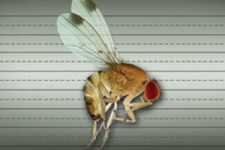Take A Swat At Spotted Wing Drosophila

The spotted wing drosophila (SWD), Drosophila suzukii (Matsumura) is an invasive pest that was first recorded in Hillsborough County, Florida in 2009. Since that time, the fly has spread to at least 28 of Florida’s counties. Crops that are at direct risk in Florida as a result of SWD invasion include blueberry, strawberry, grapes, blackberry, and other thin-skinned fruit. SWD originated in Southeast Asia and was first recorded in the continental U.S. in California during 2008. However, the fly has been in the Hawaiian Islands since 1980s. In California, up to 40% losses have been recorded in blueberries. Similarly, Florida blueberry growers suffered about 15% loss during the 2012 production season, and the fly was recorded in all of the blueberry growing regions except DeSoto County.
SWD impacted fewer blueberry growers in Florida during the 2013 season compared with 2012 because growers were aware of the fly and its potential risks and began their management program early in production season before the fruit were in a susceptible stage. In addition, the University of Florida, Small Fruit and Vegetable IPM Laboratory was proactive and provided SWD management recommendations for blueberry growers early in the production season.
Spotting SWD
SWD resembles the common Drosophila fruit flies that feed on over-ripe strawberries that have not been refrigerated. However, the male SWD has a dark spot near the tips of each wing that can be seen with the naked eye or by using a hand lens. In addition, the male has black spots at the base of the forelegs. A female SWD has an enlarged egg laying organ with saw-like teeth at the base of the abdomen, which is used to cut into thin-skinned fruit to place their eggs. The eggs that hatch inside fruit become small white maggots that soften the fruit as it develops rendering the fruit unmarketable. Common drosophilid flies lack this organ and can only lay eggs in soft over-ripe or rotting fruit.
Taking Control
The management of SWD involves a 1) effective monitoring, 2) use of cultural techniques, and 3) application of pesticides from various classes. Current monitoring methods for SWD adult flies employ various types of traps and baits. The standard trap that has been used consists of a plastic container with a lid, entry holes, and liquid bait (apple cider vinegar or yeast-sugar water) that also acts as an attractant and drowning solution. Two drops of odorless dish soap can be added to the bait (apple cider vinegar or yeast-sugar solution) to break the surface tension to prevent flies from escaping. In addition to adult monitoring, larval monitoring must be done on a periodic basis (at least once every two weeks) using the salt test. This involves randomly collecting at least 30 healthy, undamaged fruit from your field and placing them in a re-sealable plastic bag. The fruit should be lightly crushed inside the bag and a salt solution should be added. The mixed salt solution should be approximately ¼ cup of salt to four cups of water. If the fruit is infested, the larvae will float to the top.
Cultural control strategies are important tactics that are available to all growers and can prevent the outbreak of SWD in fruit crops. These tactics involve regular harvesting of ripe fruits and managing host plants in surrounding or adjacent fields. Host plants can be managed by either direct spraying of the host or implementation of border sprays around the cultivated field. If resources are available direct removal of host plants also may be appropriate. Frequent harvesting of fruit crops will keep susceptible fruits out of the field and reduce the potential for SWD infestation.
The application of pesticides should be based entirely on monitoring data. These data should be obtained from monitoring traps or taken from larval counts in fruits. However, extra precautions should be taken with data from larval counts because by the time these data are available, the field could already be infested with SWD.
Adult fly data from traps are very useful since it is possible that these flies have not laid any eggs in the fruit. Regardless, once SWD is recorded in the field, growers should embark on a spray program on a 10- to 14-day cycle until no flies are recorded in the traps. When pesticides are applied, growers should rotate from various classes in order to preserve the effectiveness of the pesticide. The use of pesticides from the same class would increase the potential for insecticide resistance and possibly flare up the chances for outbreaks of secondary pests.
Growers must follow the label when using pesticides and employ a program involving regular monitoring for adults and larvae to determine how long pesticide tactics should be continued.










